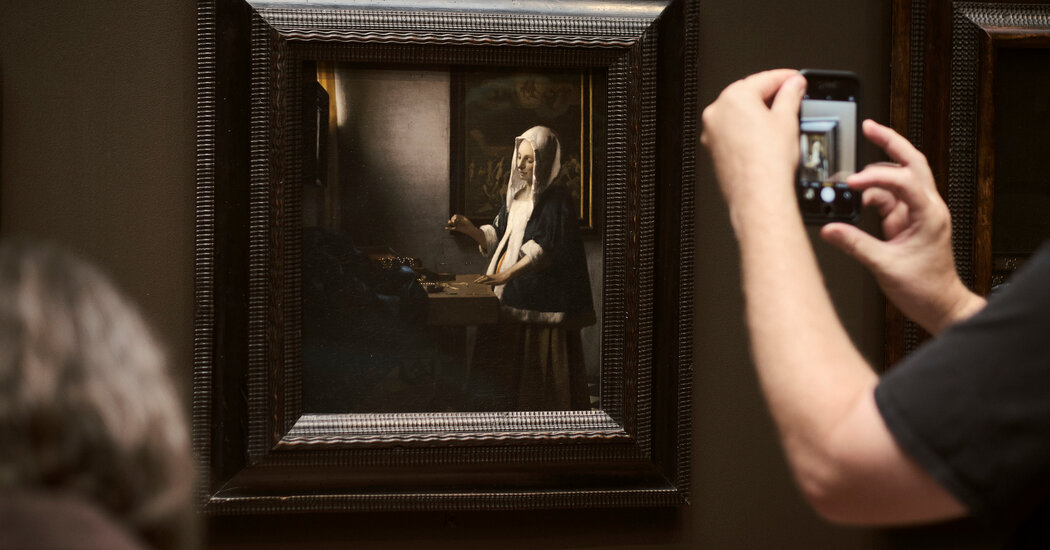
WASHINGTON — Here is a question that art experts at the National Gallery of Art are trying to tackle: Are a couple of paintings in the museum’s collection that are credited to Johannes Vermeer actually the work of Vermeer, the 17th-century Dutch artist noted for his detailed, realistic portrayals of middle-class life?
The two paintings are not obvious fakes. Indeed, one is considered a masterpiece, but they are unusual in the oeuvre of Vermeer: smaller than his other works, and painted on wooden panels instead of canvas.
“And so they seem to be somewhat different from the rest of his work,” said Melanie Gifford, a research conservator at the National Gallery.
“Girl With the Red Hat” is among the 34 artworks that are almost universally regarded as genuine Vermeers. The other, “Girl With a Flute,” is “only cautiously attributed to Johannes Vermeer,” the museum’s website says, as it “does not match the master’s standards.”
And yet, “Girl With a Flute” shares stylistic similarities with “Girl With the Red Hat” and other Vermeer paintings. On the other hand, if “Girl With a Flute” is not an authentic Vermeer, perhaps “Girl With the Red Hat” is not, either.
“There have been doubts about the attribution for many years,” Dr. Gifford said.
Art experts, aided by a scientist who used to design cameras for reconnaissance planes, are increasingly taking advantage of a technique that is also used to study Mars to help answer questions like this.
Scanning the Gallery
The Covid-19 pandemic turned out to be a boon for the science of art. When the National Gallery and other museums closed temporarily, venerated paintings could be taken down for study without incurring the wrath of disappointed visitors.
John K. Delaney, a senior imaging scientist at the National Gallery, said he and a colleague, Kathryn Dooley, “quietly went in, for six to eight weeks, and imaged the hell out of all of our Vermeers, including the ones that have some question marks.”
Much about Vermeer, who died in 1675 at age 43, remains shrouded in mystery; his work was nearly forgotten for two centuries until critics rediscovered it in the 1800s and hailed him as a master in the use of color to capture gradations of lighting, shadows and textures.
“What we’re trying to do is establish an understanding of his painting techniques,” Dr. Delaney said. “People are trying to figure out, Is this all Vermeer, or is someone else also getting involved in it?”
The National Gallery also owns two canvases that, like “Girl With the Red Hat,” are confidently attributed to Vermeer. Those three paintings, and “Girl With a Flute,” are now back on display in the west wing of the museum, which reopened in May. But the study of the data continues.
In the past, all that art curators and conservators had to work with was what they could see on the surface of the artwork and whatever they could unearth in historical documents. Occasionally, they might remove a speck of paint to analyze an artwork’s layers.
X-rays provided some of the first looks at what could lie beneath the visible top layers. Through a technique called X-ray fluorescence, the same high-energy particles of light can also be used to identify elements like zinc, lead and copper that are found in certain paint pigments. These elements absorb X-rays and re-emit the energy at characteristic wavelengths, a sort of atomic fingerprint.
Dr. Delaney’s specialty, reflectance imaging spectroscopy, is one of the newer methods, taking advantage of the fact that different molecules absorb light at different wavelengths. By analyzing the brightness of colors bouncing off something, scientists can often identify what that object is made of. That is of great use to geologists studying minerals on the surfaces of landscapes. The technology helps pharmaceutical companies ensure purity of their medicines, and intelligence experts use similar images taken by satellites and aircraft to find hidden enemy targets.
“You can distinguish between, well, I won’t say too much, but you can distinguish between some different types of painted objects and natural objects,” said Dr. Delaney, who worked for a company that designed cameras for U-2 reconnaissance planes before joining the National Gallery.
Geologists found this to be a useful technique, too. By flying over an area with a sophisticated camera collecting data at visible and infrared wavelengths, they could identify different types of rocks. NASA’s Mars Reconnaissance Orbiter and the Curiosity and Perseverance rovers use reflectance imaging spectroscopy to identify minerals on the red planet.
Marcello Picollo, a researcher at the Nello Carrara Institute of Applied Physics in Florence, Italy, was part of the team that was the first to apply the technique to the study of artwork. Trained as a geologist, he realized that many pigments are essentially crushed minerals. Reflectance imaging spectroscopy can also identify organic molecules like those found in cochineal insects that have been pulverized to produce a deep red pigment.
“It’s a great, powerful technique for investigating,” Dr. Picollo said.
But these camera systems had to be modified to fit the needs of art museums: to study the paintings up close and at high precision without bright, potentially damaging light.
At about the same time that the Italian scientists developed their systems, Dr. Delaney started consulting for the National Gallery of Art.
The early devices Dr. Delaney used could take images at several wavelengths, so they were called multispectral cameras. Over time, the devices became more sophisticated, able to differentiate between many more wavelengths. They are now described as hyperspectral instead of merely multispectral.
In 2007, the National Gallery hired Dr. Delaney full time, and he began collaborating with art experts around the world including those at the J. Paul Getty Museum in Los Angeles, England’s National Gallery in London and the Rijksmuseum in Amsterdam.
“John was the guy who really opened the door for this massive use of this technique,” Dr. Picollo said.
When Dr. Dooley finished her doctorate in chemistry in 2010, she was looking for a job that made use of her skills in spectroscopy. She came across a fellowship at the National Gallery.
“I always thought I would work in industry somewhere, applying spectroscopy to analyze something,” said Dr. Dooley, now a research scientist at the museum. “And it just happens I get to analyze artwork, and that’s pretty cool.”
The laboratory at the National Gallery has a motorized easel that moves a painting in front of a camera, back and forth, up and down. For each point, the camera gathers detailed reflectance information across a range of wavelengths, generating gigabytes of data during an hourlong scan. The hyperspectral camera can also be swapped with an X-ray fluorescence instrument.
Many of the gallery’s art historians were not initially excited when Dr. Delaney and Dr. Dooley first showed them graphs about light absorption. But they started to come around.
A few years ago, David Alan Brown, the curator of Italian and Spanish paintings, asked if the techniques might help answer some questions he had about “The Feast of the Gods,” a 16th-century painting by Giovanni Bellini that depicts a mythological scene with Jupiter, Mercury, Apollo and other Olympian gods at an outdoor banquet. It was later substantially repainted by a student of Bellini’s — Tiziano Vecellio, more commonly known as Titian, who was perhaps the greatest of the Renaissance painters in Venice.
Titian changed the background, adding a mountain that covered up trees that Bellini had painted, and Dr. Brown, now retired, “wanted to know exactly what the forest looked like,” Dr. Delaney said. “Kate found all the trees,” he said. “And then we were able to get some foliage information.”
That led to a color reconstruction of the original painting.
“We answered a lot of his questions,” Dr. Dooley said.
What Lies Beneath
Dr. Delaney’s collaborations with the Getty museum include hyperspectral scans that cast light on a hidden painting under Rembrandt’s “An Old Man in Military Costume.” It has long been known that Rembrandt painted this work on top of another, and X-rays showed that the first painting was “completely upside down from the painting that’s on the top,” said Karen Trentelman, the head of technical studies at the Getty.
It was another portrait, roughly of the same size, but not much else was known.
“When you’ve got a hidden Rembrandt, you want to find out what it is,” Dr. Trentelman said. “But of course, you’re not going to scrape off the upper Rembrandt to get to it.”
The Getty did not own a hyperspectral camera, so Dr. Delaney came to help. “He would actually pack this thing up and fly out here to Los Angeles and work with us on it,” Dr. Trentelman said. “We invite him out here in like January and February, when it’s nice in Los Angeles and really miserable in Washington.”
X-ray fluorescence scans showed the distribution of iron and copper atoms in the first painting, which indicated a younger man dressed in a robe. The hyperspectral imaging revealed more: no less than four sets of eyes.
“He seemed to be sort of searching on where to place the eyes,” Dr. Trentelman said.
Dr. Delaney has also helped scan Vincent van Gogh’s “Irises,” possibly the most popular painting in the Getty’s collection.
The flowers in the painting are now blue, but in a letter to his brother Theo, van Gogh described them as violet. “Can we find evidence that would point to a color change, which we think is very probable?” Dr. Trentelman said. “Van Gogh was notorious for using paints that changed colors and faded.”
That, in turn, could give people a sense of what the artwork used to look like. “We could create a digital color reconstruction, to kind of say, ‘Hey, here’s what it might have looked like when it was fresh,’” Dr. Trentelman said.
But there is definitely no hidden painting under “Irises,” she said. Rather, it is a more subtle study of how van Gogh created his paintings, offering information that can help conservators preserve it.
With Dr. Delaney’s help, the Getty is buying a hyperspectral camera system, which is expected to arrive in the coming months, Dr. Trentelman said.
Back at the National Gallery of Art, hyperspectral reflectance and X-ray fluorescence scans of the Vermeer paintings helped identify pigments and provided insights into how Vermeer worked.
The multitude of hyperspectral data can be used to create false-color images, much like the ones that planetary scientists use to pick out subtle details in alien landscapes.
Vermeer’s paintings are renowned for their precise detail — so precise that some have proposed that he used an optical device called a camera obscura to delineate the correct perspectives — yet the infrared and X-ray imagery also shows rougher brush strokes in the lower layers.
“In his preparatory phases, when he’s kind of laying out the composition, it’s pretty quick,” Dr. Dooley said. “And it’s kind of sketchy. It’s kind of brushy. And it’s more loosely handled than what I think the public often thinks about when they think of Vermeer.”
As for questions about who really painted “Girl With the Red Hat” and “Girl With a Flute,” Marjorie E. Wieseman, the head of the National Gallery’s department of northern European paintings, said cautiously that there were no conclusions yet.
“There are some anomalies in the paintings in terms of how they relate to other works by Vermeer,” she said. “How many can you plausibly account for, and how many remain curiosities and just something from left field?”
Dr. Gifford said she and the other researchers hoped to put their findings in a paper by next year.
“We’re still arguing,” Dr. Gifford said.




